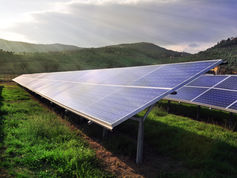Can Carbon Credits Save Africa's Trees from Charcoal?
- Ray Mwareya
- Oct 7
- 3 min read
A new carbon-credit scheme in the southern arc of Africa wants to work ethically where others have been beset with accusations of land colonialism, corrupt deals, and ‘green washing’.
Charcoal crisis
In Zambia, the burning of natural woodlands is at a crisis point. Every year, an area about the size of Yosemite National Park is razed down to burn charcoal, according to an estimation by the London School of Economics.
“It’s an ugly spectacle,” Angeline Musonda, the executive director of Care for Nature Zambia, a local ecology monitoring group in Zambia, says, describing the country's charcoal harvesting crisis.
Most of Zambia's population lives in rural areas where joblessness is a part of life. As a result, the poor burn down forests daily, often randomly, until the black soot is collected as charcoal for resale as a heating and cooking fuel in the cities.
Reversal
To reverse this trend, project developers Climate Impact Partners and Community Climate Solutions (CCS) have recently embarked on a partnership to empower rural farmers in Zambia to plant trees, harvest them sustainably, and protect them from charcoal poachers. The project is called the Miombo Woodland Restoration Project. Miombo is an indigenous name that refers to the Brachystegia (scientific name), a sturdy, all-season hardwood tree that is common in the southern part of Africa. The Climate Impact Partners and CCS are global nonprofits working to finance climate protection solutions, especially in sub-Saharan Africa, where the concept of carbon credits is still misunderstood, poorly implemented, or has no takers.
“The goal is to enrich the livelihoods of Zambia’s rural farmers so that forests thrive and soak (up) excess carbon,” says Samuel Gantner, founder of CCS.
Putting ‘money on the table,’ in the form of carbon finance, is the most impactful way to reach the goal, he explains. Not only are farmers in rural Zambia already restoring woodlands, but soil health is also crucial to food security across Zambia, and as a result, much of Africa is nourished.
Ultimately, 1 million hectares of woodland, an area about the size of Puerto Rico, would be planted. Accordingly, 2 million metric tons of carbon dioxide are slated to be removed from the air yearly by 2030. 25,000 farmers have already signed up for the project. If progress accelerates, 50,000 ‘ecopreneurs’ will be created.
Carbon ‘corruption’
Innovative carbon credit schemes across Africa have had a dodgy start in the five years since the concept first reached the continent. The Africa Carbon Markets Initiative states that just 2%-11% of the global carbon credits trade has involved Africa to date, despite the continent being home to the Congo Basin Forest, colloquially referred to as ‘the lungs of the earth’.
Initial carbon credit schemes rolled out in Africa have been criticized as ‘green washing’. Climate expert Tapuwa Nhachi explains the dodgy projects created to fleece investors of equity, scam local people out of their lands, or ploys by foreign corporates doing business in Africa to ‘pollute and pretend to pay’. For instance, the Kariba REDD project, whose aim was to protect 800,000 hectares of forest, was reported by a Guardian analysis to vastly overestimate the climate benefits. Despite earning more than $ 100 million in revenue from corporations, only a tiny fraction of the money reached local communities.
“The history of carbon credits in Africa is replete with land loss, colonialism, elite corruption, and deceived local communities,” says Nhachi.
It will be a high bar for this latest scheme in Zambia to prove its worth, he explains.
Fresh air
To distinguish this latest project from past failed endeavors, it is envisioned that 60% of the money accrued from selling carbon credits will be directly deposited into the local community's coffers. For instance, from January 2026, farmers will receive approximately $80 for the first tree planting payout. More annual payments will be made to sustain the trees. The average annual income in Zambia is anything from $150 to $400.
“This is a refreshing change, we are already earning, seeing promises kept,” says Chipo Mwale, a rural farmer of corn and maize who lives in a township near Lusaka, the capital of Zambia, and is a participant in the project.
Mwale recalls an earlier project in her community led by a Chinese company. They were promised $50 a month for planting at least 10 trees a farmer.
“We did that, they would take pictures of the freshly planted trees to show foreign corporations and donors, we were promised a lump sum payment after 12 months. The company vanished without goodbye,” she says.
Better way
Under this new initiative, some tree cutting is permitted for local farmers to use as charcoal, says Mwale. “But we now harmlessly do this – targeting only those trees that don’t add to the health of the forest”.









